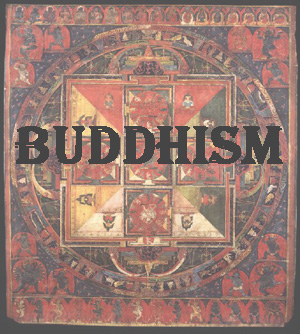
Rundlett Middle School
The Indian Subcontinent: The Land, The People, The Culture
| HOME |
| Introduction |
| Mandalas |
| Hinduism |
| Buddhism |
| Silk Road |

Buddhism is a religion that originated in northern India about 2500 years ago with the teachings of Siddhartha Gautama, a man who was born a prince into a wealthy Hindu family. The Buddha meditated under a Bodhi tree, eventually reaching enlightenment then traveled around teaching about what he learned. Through his stories, he taught the basic teachings, The Four Noble Truths and The Eightfold Path, which form the foundation of the religion. His disciples became the world's first missionaries, spreading his teachings throughout the subcontinent, and then north into Asia and Europe along the Silk Road. Buddhism has gained a lot of popularity in the United States during the past several years. The common stereotype about Buddhism is that it is a plain and simple religion without a lot of ritualism. This is not at all the reality. After spreading out of India via the traveling monks, each society that adopted Buddhism adapted the teachings to meet the needs of their culture and community at the time. Although the religion basically teaches its followers to be kind, gentle, generous, and honest, it has become imbedded with very complex rituals that are recorded in Buddhist "canons" which are memorized and taught by Buddhist monks in monasteries.
Link to Teachings of the Buddha
Buddhist populations worldwide today
Click on the following YouTube links to hear Buddhist Chants:
Buddhist Chant - Heart Sutra 4:53
Tibetan Buddhist Chanting - Om Mani Padme Hum 48 sec.
Tibetan chant for enlightened mind 52 sec.
When most people think of Buddhism, they visualize a peaceful image of the Buddha in seated meditative position. The images of Buddhism are deep and complex, and integrated within the ritualistic practice of the cultures. Tibetan Buddhist images are very complex. To stimulate students' thinking about Buddhist images, and to extend their reality of what Buddhist images are, display the following table of Buddhist images with an LCD projector. Ask students which image or images they think are Buddhist images. The answer is that all the images are Buddhist images. Click on each image to view a larger image and ask students what they notice about it. You can use the things they notice as a spring board for discussion and to connect to the morals and ethics they learn about in the Jataka tales lessons below.
Link to table of Buddhist images
Click on the following link for an activity for teaching about the Buddha's life and additional links to information about his life story.
Activity for the Buddha’s Life
Jataka Stories
Just like parents in our culture use stories to teach moral values, so do people in other cultures. Buddhist stories, called Jataka stories, are told to children from the time they are very young to teach Buddhist moral and ethical values.
Click on the following link to learn more about Jataka stories and activities to use with them.